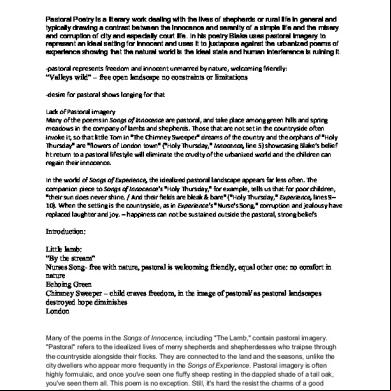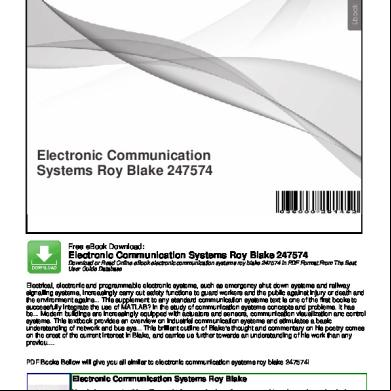Blake Pastoral 4p6e30
This document was ed by and they confirmed that they have the permission to share it. If you are author or own the copyright of this book, please report to us by using this report form. Report 2z6p3t
Overview 5o1f4z
& View Blake Pastoral as PDF for free.
More details 6z3438
- Words: 1,861
- Pages: 4
c
’ ’
x ! 2
"# $ # %# & % %' # %% %(%' # % )* +
, " 2 , "# 2 %' # %
% $ "-. /%(%' # % 01 23*"c %45%6 $ 6"1
` x ! " # $ ë 2 J J ’
J 2 ’ J ! J ! " J ! #
$% J &#'% ( ( " (
)%
% &% (% ,% /% 3%
% ' % ) % * + %+ ' % ! % - * . % 0 % 1% 2
% 2 2 % - + + #% - 4 5 # ' (, 2 2% 6% ' (, 7% & 8% - 9:; < ` % =% ( &>%1 2 % &&%, &(%1 ? 2% &,%/ &/%@ ` 2 # ` # < % &3%2 A + # + +B2 # CD+ - # % E 2 * % The representation of children in µThe Echoing Green¶ portrays this innocence through recognisable conventions. Pastoral imagery features strongly, with the village green shown to be the centre of community life. The children are unrestricted and follow the natural rhythm of life, ceasing their play at dusk. The overall impression created is that of a strong connection between childhood and nature, ed by the simile comparing children to µbirds in their nest¶ (ln 27). However, on closer reading there are hints of disharmony. The effect of industry is addressed in lines 6-8: µThe birds of the bush, Sing louder around, To the bells cheerful sound¶. As suggested by Brown, ³the birds must raise their volume to compete with these man-made noises´. In addition, the description of the green as µEchoing¶, suggests a distortion of the pastoral idyll. Rudd states ³the poem speaks of a shallow representation of the past, almost as a shadow of a former glory which does not feel full bodied to re-create present day reflections over a fondly ed youth.´
"
J
JJJ
J
J# ( J J J
J( J
J J J( J J J J J
* J "
5# 785
"# 85 85 $ "# 8585 85 8585 859 : 85" 85859 : " 9 : $ $ 85 85" # $ "#
" 85
"'$
8585 85 ." . 85# 8585 85" c 85
85 , 8585 85 85"# "
ƒ * 2 # +# *%+ 1 + # %+ - + ? + ` % ` &=3= : !2 + ? + +- ! + # % 1 * ` + # # %+ - `
+ + %
` # + J # %
u
J
u
, JJ
u
,
JJ #
- +
. JJ
" # J
/ J # .
J 2
0 J 1-
+ 2
3+ %
u
*
u
’ +
4
u
0
u
*
! 4 5 2 # " J J * J
’ ’
x ! 2
"# $ # %# & % %' # %% %(%' # % )* +
, " 2 , "# 2 %' # %
% $ "-. /%(%' # % 01 23*"c %45%6 $ 6"1
` x ! " # $ ë 2 J J ’
J 2 ’ J ! J ! " J ! #
$% J &#'% ( ( " (
)%
% &% (% ,% /% 3%
% ' % ) % * + %+ ' % ! % - * . % 0 % 1% 2
% 2 2 % - + + #% - 4 5 # ' (, 2 2% 6% ' (, 7% & 8% - 9:; < ` % =% ( &>%1 2 % &&%, &(%1 ? 2% &,%/ &/%@ ` 2 # ` # < % &3%2 A + # + +B2 # CD+ - # % E 2 * % The representation of children in µThe Echoing Green¶ portrays this innocence through recognisable conventions. Pastoral imagery features strongly, with the village green shown to be the centre of community life. The children are unrestricted and follow the natural rhythm of life, ceasing their play at dusk. The overall impression created is that of a strong connection between childhood and nature, ed by the simile comparing children to µbirds in their nest¶ (ln 27). However, on closer reading there are hints of disharmony. The effect of industry is addressed in lines 6-8: µThe birds of the bush, Sing louder around, To the bells cheerful sound¶. As suggested by Brown, ³the birds must raise their volume to compete with these man-made noises´. In addition, the description of the green as µEchoing¶, suggests a distortion of the pastoral idyll. Rudd states ³the poem speaks of a shallow representation of the past, almost as a shadow of a former glory which does not feel full bodied to re-create present day reflections over a fondly ed youth.´
"
J
JJJ
J
J# ( J J J
J( J
J J J( J J J J J
* J "
5# 785
"# 85 85 $ "# 8585 85 8585 859 : 85" 85859 : " 9 : $ $ 85 85" # $ "#
" 85
"'$
8585 85 ." . 85# 8585 85" c 85
85 , 8585 85 85"# "
ƒ * 2 # +# *%+ 1 + # %+ - + ? + ` % ` &=3= : !2 + ? + +- ! + # % 1 * ` + # # %+ - `
+ + %
` # + J # %
u
J
u
, JJ
u
,
JJ #
- +
. JJ
" # J
/ J # .
J 2
0 J 1-
+ 2
3+ %
u
*
u
’ +
4
u
0
u
*
! 4 5 2 # " J J * J










